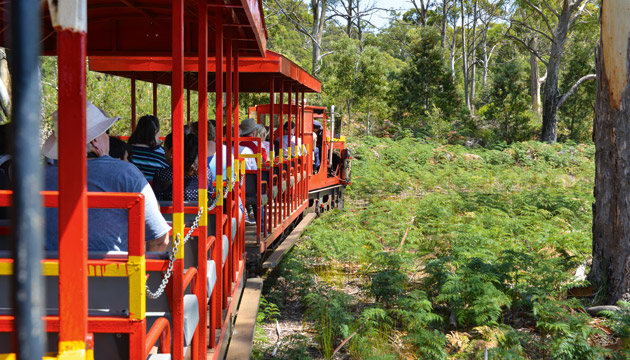Australia’s most southerly railway travels a route through Tasmania’s history.
Story by Ken Eastwood
"This little railway trundles right through Tasmania’s history,” Dave Collins says proudly. In Tasmania’s deep south, Dave places a hand on one of the trusty Malcolm Moore engines that pull tourists along Australia’s most southerly railway – the two-foot (60 centimetre) gauge Ida Bay Railway. He is one of the active members of the Friends of Ida Bay Historical Society who help keep this history alive. “I’m from New South Wales originally,” he says. “I escaped from that other island to the north. And as a boy I always wanted a train set.”
Built in 1922 to carry limestone from quarries in the headwaters of the Lune River to a wharf at Ida Bay, the line was opened as a tourist attraction 40 years ago, but Dave says its travel through time starts much earlier than that. For a start, it goes past middens and sites special to the Lylequonny people. “We don’t know much about them, but what we know about them is their encounters with the French, who were out looking for La Perouse,” he says. The French explorer had gone missing around 1788, and many of the features in southern Tasmania were named by those who came looking for him, including the D’Entrecasteaux Channel and Lune River, where today’s 14-kilometre out-and-back rail journey starts. The train travels over buttongrass plains and through tea-tree woodlands and forests where timber-getters worked for many years harvesting Tasmanian oak and other hardwoods, creating a small settlement at Ida Bay. Convict work crews sent out from Port Arthur were some of the first harvesters, and later, wooden tracks were built for horse-drawn tramways to cart the timber. “There’s tens of kilometres of tramways constructed through here,” Dave says.
Today, travelling no more than 14km/h, the little train clunks and clanks, squeals and shakes on metal tracks, taking two or three carriages of passengers past Ida Bay to a little bush cemetery, where driver Damo McKay gets everyone out for his fast-paced narrative of 120 years of Tasmanian history. He describes the lives and tragic deaths of each person in the cemetery. “The Tyler family basically kicked off everything in the south of Tasmania,” he says. Here lies Edwin Tyler, a timber-cutter who fell on a circular saw and died aged 14. There’s his brother Ernest, who died at 19, probably killed by other timber-getters, although it was made to look like an accident, Damo says. “He was laid out after a fight and they felled a tree on him. The family couldn’t prove it was foul play though.”
Back in the train, through endangered swift parrot habitat and past wallabies and swooping eagles, Damo takes it carefully around every scenic bend. “Back in the day when this train was carrying limestone, it was off the track every day, mainly because of the amount of weight they were carrying,” he says. Some of the bogies underneath the passenger carriages still date back all the way to the 1890s, but the Malcolm Moore engine – which today is powered by a five-gear, diesel Isuzu excavator motor installed in the 1980s – was originally used in World War II in the Philippines to move equipment around military bases. Five of them ended up being used on this railway. “This is one of the last Malcolm Moore’s left,” Damo says. “They don’t make ’em like they used to – this is extremely reliable.”
From 1922 to 1975 the railway transported limestone to vessels, such as the Cathkit and Alma Doepel. The stone was then shipped to Electrona Carbide, near Hobart, and used to produce calcium carbide for use in steel manufacturing and the chemical industry. Continuing the trundle through history, Dave says that after World War II, many of the quarry workers were European migrants, and they worked hard in stifling and remote conditions in the quarry in the hills. After it was discovered that the limestone quarry was starting to negatively affect one of Australia’s longest limestone cave systems, the government purchased the railway and rolling stock and turned it into a tourist railway.
This story excerpt is from Issue #109
Outback Magazine: Oct/Nov 2016










